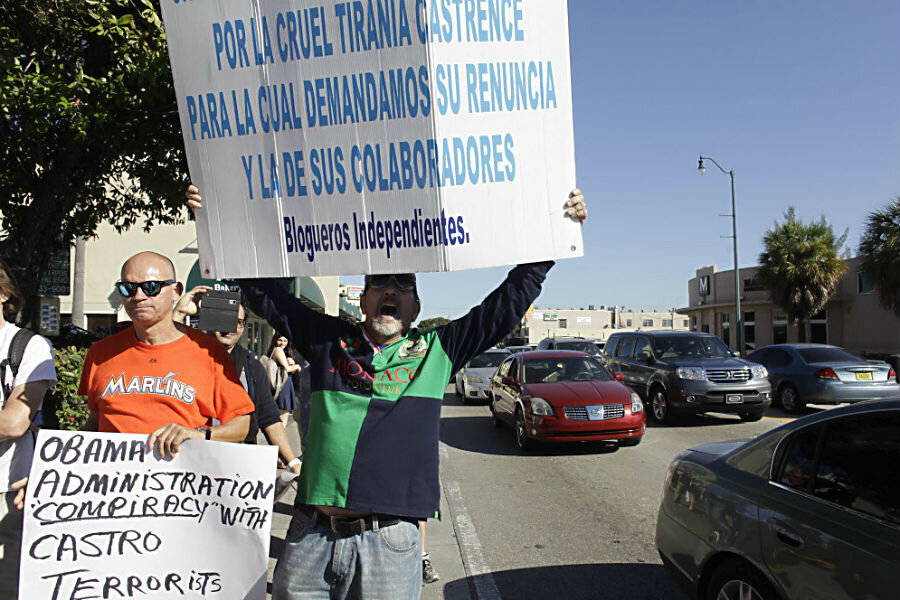Why Miami's Cuban-Americans are divided on US thaw with Cuba
Loading...
| Miami
When President Obama announced his policy shift on Cuba Wednesday, complete with restoring diplomatic relations, no one was more riveted – or torn – than South Florida and its outspoken Cuban-American community.
But for much of the day, calm persisted in Miami. Reporters outnumbered protesters at Café Versailles in the city’s Little Havana neighborhood, long the go-to spot to hear heated talk about politics on the island 90 miles south of the continental US. As night set in, however, more protesters turned out, and news crews found irate Cuban-Americans who lambasted the White House's move as a sop to the Castro regime.
But the Café Versailles’ demographic is just one segment of the Cuban-American community today. There are many who say they understand the need to take a different tack, after five decades of the embargo.
"It’s time to move on. It's no longer Kennedy; it's no longer the '60s," says Fernando Miro, an office manager who was born in Miami to Cuban exiles and whose father, a former attorney in Cuba, was involved in the anti-Castro Bay of Pigs invasion and was held afterwards as a political prisoner by the Cuban government. He characterized the embargo as "obsolete" and unfair. "I understand the idea, but it didn’t work. I think they’ve run out of excuses and they’re seeing what a waste it has been.”
Former Miami Mayor Manny Diaz, who backed the policy shift in a statement today, also numbers among those supporting the change.
"As a Cuban exile whose father was held as a political prisoner by the Cuban regime, I have experienced the oppression of the Cuban government firsthand," he said. "However, for more than 50 years we've tried it one way. The time has come for a different approach."
More than half of Cuban-Americans here agree with Mr. Miro and Mr. Diaz, according to surveys. In the 2014 edition of Florida International University’s annual Cuba poll, only 48 percent of Miami-Dade County’s Cuban-Americans said they support continuing the embargo – down from 87 percent when the poll began in 1991 – and 68 percent said they favored diplomatic relations. That number goes up to 90 percent when confined to the 18 to 29 age group.
“There is no monolithic Cuban community,” says Guillermo Grenier, a professor of sociology at FIU and the principal investigator of the Cuba poll. “The most striking thing is how much the population changes based on the time that they arrive in Miami, what pushes them out of Cuba.”
He pinpoints the year 1995 as a dividing line – the year the US instituted the so-called “wet foot, dry foot” policy, which allowed any Cuban refugee who managed to set foot on American soil – or, more likely, beach – to stay and eventually become a citizen. Earlier immigrants often had more means and a more ideological reason for leaving. By the 1990s, poverty was more likely to be the driving force.
The post-1995 wave, about one-third of the community, is more in favor of softening hardline policies on Cuba, he says.
But there was still plenty of outrage and shock expressed Wednesday.
"This entire policy shift announced today is based on an illusion, based on a lie,” Sen. Marco Rubio, a son of Cuban immigrants, lashed out on Capitol Hill today. "The White House has conceded everything and gained little." He threatened to block the policy changes broached today.
Those words would resonate most strongly with the pre-1995 demographic, who Grenier says also have more political clout.
“The earlier exiles – the Cuban revolution was a seismic event in their lives and they came because their lifestyle was totally changed. They were hoping to come to the US for a few years and return to a status quo Cuba,” Professor Grenier says. “Those who came before 1980 are doing pretty well; those are the movers and shakers in our community here.”
Grenier says that the survey has made clear the later waves of immigrants are more amenable to Obama’s policy shift. But they are rarely heard at the same volume as their predecessors, he adds, whether because of weaker ideology or fewer financial resources. Only about a third of them have become citizens.
“The folks that want more normal relationships are not the ones most politically engaged,” he explains. “The new guard have a plethora of concerns and Cuba might be one of them, but it’s not the driving force of their voting patterns.”
But 58 percent of that cohort who arrived between 1995 and 2014 oppose continuing the embargo, compared with 43 percent who came between 1965 and 1973.
If you pay attention to what is happening on the ground, rather than the rhetoric, the shift in attitudes among exiles becomes clear, says Joe Garcia, an outgoing congressman from South Florida born to Cuban exiles.
“He may be ahead of the normative behavior, but not normative beliefs,” says Congressman Garcia, referring to Obama’s announcement today. Some “600,000 people traveled to Cuba in 2014. People voted with their feet.”
Miro is among those who dreams of going back to Cuba, although he acknowledges that his late father, who created bumper stickers opposing the Communist regime that read, "¡Basta ya!" (Enough already!), would not support him going while a Castro remains in control of the country.
"My father would have been very opposed to any of us going to Castro’s Cuba. He would have not liked that,” he said.
After his release from prison, Miro said his father came to Miami. He lived in Florida and Puerto Rico for the rest of his life, but his son says that his mind was always back in Cuba.
"Cuba was the most important thing for my father, even before his own family,” Miro says, adding that when he does go back, "I will bring my father’s remains."








